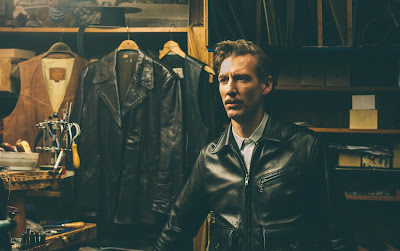Having pretty much come into early adulthood and gay/bisexual culture with the "artwork" of one, Tom of Finland, as a prominent guidepost, TrustMovies still, even now, knew nothing about the man who created the work. All that has changed with the theatrical opening of the movie that the country of Finland has submitted as a possibility for this year's Best Foreign Language Film -- something, I warrant, that Finland would never have done before or during the heyday of this artist's prominence. For much of his life, Tom, whose given name was actually Touko (according to the film, it became "Tom" due to his American publisher trying to make his work more marketable to the English-speaking crowd), would have been a near-pariah in his home country, had his work not been kept decidedly "under-cover."
As personified by the excellent actor Pekka Strang (shown above and below), Touko/Tom is brought to fine life as a young man, a middle-aged and increasing successful one, and finally the elderly gent who, having lost the love of his life even as his greatest successes occur, is left with memories. And his art.
To the film's credit, that "art" (a sample of which is shown below, and which I would call, as does Wikipedia, "erotic illustration") is never pushed forward as anything great. Instead it is shown to have a huge appeal to the gay population -- which it did and still does. With its emphasis on uniforms, leather, big bodies, and very large muscles (including those cocks), it strikes directly at certain accouterments favored by a portion, probably rather large, of the gay population.
And the drawings are indeed beautifully done: In black-and-white, they're well-composed and about as in-your-face as you could wish. The movie itself, however, is a lot more subtle that the work itself. It must be, in order to give us the fairly in-depth look at Touko and his life: first, with his sister and eventually with the young man who moves into the pair's apartment as a renter and soon becomes Tom's lover, and finally a near-rapturous view -- so different from Finland -- of gay life in the USA during the burgeoning 1970s and then into the 80s, as AIDS begins to decimate the gay scene.
In America, we're introduced suddenly to some new characters -- Jack (Jacob Oftebro, above, left, who also doubles, I believe, as Tom's gorgeous fantasy man, below) and Doug (Seuman Sargent, above, right). Why soon becomes clear, while the how is handled with enough panache to grab our interest. One of the great strengths of Karuoski's direction (he also collaborated on the story) and Bardy's screenplay come via their refusal to hand us literally everything on a large and labeled platter. Instead they make us work, and the effort is invigorating.
The film is full of such moments, and it is all the richer and stronger for them. Oh, Tom of Finland is feel-good, all right. But we've also been given enough feel-bad, along with intelligent probing of place, culture and mores, that the finale seems more than appropriate and justified.
Performances are all you could wish for, too. From the excellent leading actor, to the fine supporting roles. That's Jessica Grabowsky, above and below, center, who plays Touko's sister, and Lauri Tilkanen, below, left, in the role of Veli, the lover. If there is one big coincidence to be faced down, that would be the fact the Veli, who shows up to rent a room in the pair's apartment, is the same fellow with whom Touko has earlier had sex in the local park. I suspect this is an invention of the screenwriter, but either way, it doesn't derail the film. (I usually allow one major coincidence per movie.)
From Kino Lorber, in Finnish and German with English subtitles and some dialog in English, and running 115 minutes, the movie opens Friday, October 13, in New York City at the Quad Cinema and the following Friday, October 20, in Los Angeles (at the Landmark NuArt), Berkeley (at the Landmark Shattuck Cinema) and San Francisco (at the Landmark Embarcadero Center Cinema). To see all currently scheduled playdates, cities and theaters, click here and scroll down.
















No comments:
Post a Comment